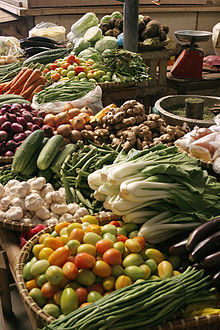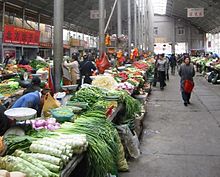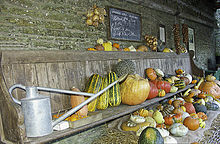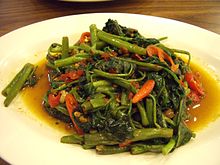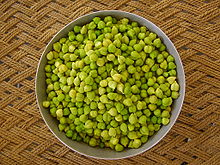
Vegetable
Did you know...
This wikipedia selection has been chosen by volunteers helping SOS Children from Wikipedia for this Wikipedia Selection for schools. SOS mothers each look after a a family of sponsored children.
In culinary terms, a vegetable is an edible plant or part of a plant which may or may not propagate into offspring. In biological terms, "vegetable" designates members of the plant kingdom.
The non-biological definition of a vegetable is largely based on culinary and cultural tradition. Therefore, the application of the word is somewhat arbitrary, based on cultural and/or personal views. For example, some people consider mushrooms to be vegetables even though they are not biologically plants, while others consider them a separate food category, some cultures group potatoes with cereal products such as noodles or rice, while most English speakers would consider them vegetables.
Some vegetables can be consumed raw, some may be eaten cooked, and some must be cooked to destroy certain natural toxins or microbes in order to be edible, such as eggplant, unripe tomatoes, potatoes, daylily, winter melon, fiddlehead fern, and most kinds of legume/beans (such as common beans). Vegetables are most often cooked in savory or salty dishes. However, a few vegetables can be used in desserts and other sweet dishes, such as pumpkin pie and carrot cake. A number of processed food items available on the market contain vegetable ingredients and can be referred to as "vegetable derived" products. These products may or may not maintain the nutritional integrity of the vegetable used to produce them.
Etymology
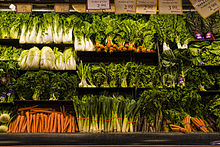
"Vegetable" comes from the Latin vegetabilis (animated) and from vegetare (enliven), which is derived from vegetus (active), in reference to the process of a plant growing.
The word "vegetable" was first recorded in English in the 15th century, and originally applied to any plant. This is still the sense of the adjective "vegetable" in biological context. In 1967, the meaning of the term "vegetable" was specified to mean "plant cultivated for food, edible herb or root." The year 1955 noted the first use of the shortened, slang term "veggie".
As an adjective, the word vegetable is used in scientific and technical contexts with a different and much broader meaning, namely of "related to plants" in general, edible or not — as in vegetable matter, vegetable kingdom, vegetable origin, etc. The meaning of "vegetable" as "plant grown for food" was not established until the 18th century.
Terminology
There are at least four definitions relating to fruits and vegetables:
- Fruit (botany): the ovary of a flowering plant (sometimes including accessory structures),
- Fruit (culinary): any edible part of a plant with a sweet flavor,
- Vegetable (culinary): any edible part of a plant with a savory flavor.
- Vegetable (legal): commodities that are taxed as vegetables in a particular jurisdiction
In everyday, grocery-store, culinary language, the words "fruit" and "vegetable" are mutually exclusive; plant products that are called fruit are hardly ever classified as vegetables, and vice-versa. The word "fruit" has a precise botanical meaning (a part that developed from the ovary of a flowering plant), which is considerably different from its culinary meaning, and includes many poisonous fruits. While peaches, plums, and oranges are "fruit" in both senses, many items commonly called "vegetables" — such as eggplants, bell peppers, and tomatoes — are botanically fruits, while the cereals (grains) are both a fruit and a vegetable, as well as some spices like black pepper and chili peppers. The question of whether the tomato is a fruit or a vegetable found its way into the United States Supreme Court in 1893. The court ruled unanimously in Nix v. Hedden that a tomato is correctly identified as, and thus taxed as, a vegetable, for the purposes of the Tariff of 1883 on imported produce. The court did acknowledge, however, that, botanically speaking, a tomato is a fruit.
Languages other than English often have categories that can be identified with the common English meanings of "fruit" and "vegetable", but their precise meaning often depends on local culinary traditions. For example, in Brazil the avocado is traditionally consumed with sugar as a dessert or in milkshakes, and hence it is regarded as a culinary fruit; whereas in other countries (including Mexico and the United States) it is used in salads and dips, and hence considered to be a vegetable.
Examples of different parts of plants used as vegetables
The list of food items called "vegetable" is quite long, and includes many different parts of plants:
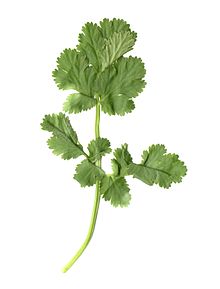
- Flower bud
- broccoli, cauliflower, globe artichokes, capers
- Seeds
- Sweet corn (maize), peas, beans
- Leaves
- kale, collard greens, spinach, arugula, beet greens, bok choy, chard, choi sum, turnip greens, endive, lettuce, mustard greens, watercress, garlic chives, gai lan
- Leaf sheaths
- leeks
- Buds
- Brussels sprouts
- Stem
- Kohlrabi, galangal, and ginger
- Stems of leaves
- Stem shoots
- asparagus, bamboo shoots
- Tubers
- Whole-plant sprouts
- soybean ( moyashi), mung beans, urad, and alfalfa
- Roots
- Bulbs
- Fruits in the botanical sense, but used as vegetables
- tomatoes, cucumbers, squash, zucchinis, pumpkins, peppers, eggplant, tomatillos, chayote, okra, breadfruit, avocado, green beans, and snow peas
Nutrition
Vegetables are eaten in a variety of ways, as part of main meals and as snacks. The nutritional content of vegetables varies considerably, though generally they contain little protein or fat, and varying proportions of vitamins such as Vitamin A, Vitamin K and Vitamin B6, provitamins, dietary minerals and carbohydrates. Vegetables contain a great variety of other phytochemicals, some of which have been claimed to have antioxidant, antibacterial, antifungal, antiviral and anticarcinogenic properties. Some vegetables also contain fibre, important for gastrointestinal function. Vegetables contain important nutrients necessary for healthy hair and skin as well. A person who refrains from dairy and meat products, and eats only plants (including vegetables) is known as a vegan.
However, vegetables often also contain toxins and antinutrients such as α-solanine, α-chaconine, enzyme inhibitors (of cholinesterase, protease, amylase, etc.), cyanide and cyanide precursors, oxalic acid, and more. Depending on the concentration, such compounds may reduce the edibility, nutritional value, and health benefits of dietary vegetables. Cooking and/or other processing may be necessary to eliminate or reduce them.
Diets containing recommended amounts of fruits and vegetables may help lower the risk of heart diseases and type 2 diabetes. These diets may also protect against some cancers and decrease bone loss. The potassium provided by both fruits and vegetables may help prevent the formation of kidney stones.
Dietary recommendations
The USDA Dietary Guidelines for Americans recommends consuming 3 to 5 servings of vegetables daily. This recommendation can vary based on age and gender, and is determined based upon standard portion sizes typically consumed, as well as general nutritional content. For most vegetables, one serving is equal to 1/2 cup and can be eaten raw or cooked. For leafy greens, such as lettuce and spinach, a single serving is typically 1 cup. Serving sizes for vegetable-derived products have not been definitively determined, but usually follow the 1/2 cup standard. Examples of vegetable-derived products subject to this standard are ketchup, pizza sauce, and tomato paste. Currently, there is no specific standard for measuring a vegetable serving in regards to its nutrient content, since different vegetables contain a wide variety of nutrients.
International dietary guidelines are similar to the ones established by the USDA. Japan, for example, recommends the consumption of 5 to 6 servings of vegetables daily. French dietary guidelines follow similar guidelines and set the daily goal at 5 servings.
Colour pigments
The green colour of leaf vegetables is due to the presence of the green pigment chlorophyll. Chlorophyll is affected by the pH, and it changes to olive green in acid conditions, and to bright green in alkaline conditions. Some of the acids are released in steam during cooking, particularly if cooked without a cover.
The yellow/ orange colors of fruits and vegetables are due to the presence of carotenoids, which are also affected by normal cooking processes or changes in pH.
The red/blue coloring of some fruits and vegetables (e.g., blackberries and red cabbage) are due to anthocyanins, which are sensitive to changes in pH. When the pH is neutral, the pigments are purple, when acidic, red, and when alkaline, blue. These pigments are quite water-soluble. This property can be used in rudimentary testing of pH.
Commercial cultivation
Method of vegetable production
Most vegetables are produced using traditional farming practices. However, the yield of vegetables from Organic farming is growing.
Origin countries
Of all the world's nations, China is the leading cultivator of vegetables, with top productions in potato, onions, cabbage, lettuce, tomatoes and broccoli.
Domestic cultivation
Amateur vegetable growing has a long history dating back to the establishment of agriculture and is a substantial business in itself, with one major online UK seed supplier currently offering well over 1200 cultivars of seeds, plants and potato tubers. They report that sale of vegetable seeds now outstrips that of flower seeds.
Plants are usually divided into the following categories:-
- Root vegetables (carrot, parsnip, beetroot, turnip)
- Leafy green vegetables (cabbage, broccoli, Brussels sprout, kale, spinach, cauliflower)
- Alliums (onion, leek, garlic, shallot)
- Potatoes
- Legumes (peas and beans)
- Pumpkin family ( cucumber, courgette, marrow, squash, pumpkin, gourd)
- Tomatoes
- Salad crops (lettuce, radish, rocket, celery, cress, beansprouts)
- Other vegetables ( pepper, sweet potato, corn, artichoke, asparagus, mushroom)
Each group has its own cultivation needs, but the overall requirements for the vast majority of vegetable plants are:
- deep, rich soil with a neutral or slightly alkaline composition
- plenty of sunshine
- plenty of water
- regular feeding
- regular weeding
- protection against pests such as slugs, aphids and caterpillars
The substantial literature and other media on the subject advise deep digging, annual top dressing with manure or home-made compost, and crop rotation. Other issues are also discussed at length, including:-
- raised beds
- successional sowing
- garden design
- allotments
- raising plants for competition
- comparative evaluation of different varieties
- organic gardening
Increasingly, small plants ( plug plants) are offered for sale in spring and summer.
Safety
For food safety, the CDC recommends proper fruit handling and preparation to reduce the risk of food contamination and foodborne illness. Fresh fruits and vegetables should be carefully selected. At the store, they should not be damaged or bruised and pre-cut pieces should be refrigerated or surrounded by ice. All fruits and vegetables should be rinsed before eating. This recommendation also applies to produce with rinds or skins that are not eaten. It should be done just before preparing or eating to avoid premature spoilage. Fruits and vegetables should be kept separate from raw foods like meat, poultry, and seafood, as well as any cooking utensils or surfaces that may have come into contact with them (e.g. cutting boards). Fruits and vegetables, if they are not going to be cooked, should be thrown away if they have touched raw meat, poultry, seafood or eggs. All cut, peeled, or cooked fruits and vegetables should be refrigerated within 2 hours. After a certain time, harmful bacteria may grow on them and increase the risk of foodborne illness.
Storage
Proper post-harvest storage aimed at extending and ensuring shelf life is best effected by efficient cold chain application. All vegetables benefit from proper post harvest care.
Many root and non-root vegetables that grow underground can be stored through winter in a root cellar or other similarly cool, dark, and dry place to prevent the growth of mold, greening and sprouting. Care should be taken in understanding the properties and vulnerabilities of the particular roots to be stored. These vegetables can last through to early spring and be nearly as nutritious as when fresh.
During storage, leafy vegetables lose moisture, and the vitamin C in them degrades rapidly. They should be stored for as short a time as possible in a cool place, in a sealed container or a plastic bag.
Standards
There is a series of ISO standards regarding fruits and vegetables.

